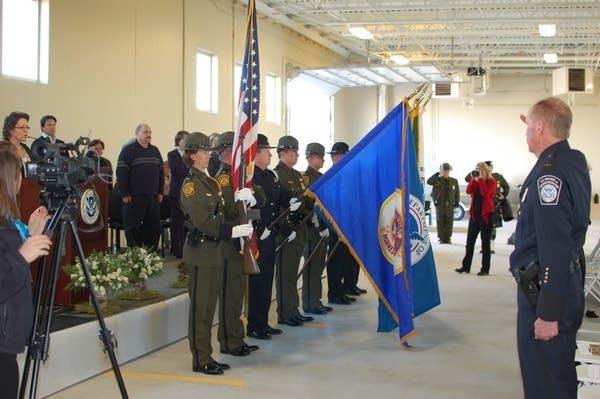Border Patrol increases visibility at new International Falls station
Go Deeper.
Create an account or log in to save stories.
Like this?
Thanks for liking this story! We have added it to a list of your favorite stories.

The U.S. Border Patrol this week celebrated the opening of a new border station in International Falls, a $6.8 million facility that points to the agency's growing focus on Northern Minnesota.
The new station is vastly larger than the agency's old headquarters in a converted two bedroom home. It's another sign that the federal agency has become much more visible in the region since the Sept. 11, 2001 terrorist attacks.
Before that day, there were only two Border Patrol agents stationed in International Falls, assigned to cover 143 miles of the U.S.-Canadian border. Today, there are more than 30 agents and support staff.
Rosa Nelly Hernandez , chief patrol agent of the Grand Forks sector of the U.S. Border Patrol, said the agency has quietly beefed up its presence in the north.
Turn Up Your Support
MPR News helps you turn down the noise and build shared understanding. Turn up your support for this public resource and keep trusted journalism accessible to all.
"We've tried to be very cognizant of the fact that the northern border doesn't require the same numbers as the southwest border does," Hernandez said. "So we're bringing in people, but very, very spaced out and into very short spurts so that we don't overwhelm the communities."
Hernandez is responsible for more than 850 miles of border in North Dakota and Minnesota, an area that is mostly wilderness.

For many decades, the U.S. government's presence in northern Minnesota has been primarily to manage forest, park and wilderness lands. That's generated resentment from some local folks. There was tension in 2006 when the Border Patrol considered expansion in Grand Marais and some local residents opposed the move.
Tensions rose a few years later when a border agent struck and killed a local resident while patrolling the Gunflint trail.
International Falls Mayor Shawn Mason said there are some people in her community who are uncomfortable seeing more federal agents in town. But Mason said the agency provides much-needed jobs in a region where the population is shrinking.
"We've seen a lot of families move back to our community," Mason said. "So it's been an infusion of new students in our school district. It's been new people in our community buying homes, and so we welcome them, of course, with open arms."
The new Border Patrol facility is set on the banks of the Rainy River for a reason. The U.S.-Canadian border in the International Falls area is all water. That means during the warm season, agents often patrol by boat. When the waterways freeze, they use snowmobiles.
Tim MacKay, the agent in charge in International Falls, said the agency uses high tech tools like motion censors and unmanned drones that fly overhead to gather information.

"The Border Patrol is getting smarter the way that it does business, with a mix of technology and people," MacKay said. "We're very remote up here, and that's probably one of the biggest things for us to overcome."
The day-to-day grind of a Border Patrol agent often involves logging lots of miles on barren stretches of highway. Most days are uneventful, agent Derek Mason said.
Locals sometimes cross the border illegally to get to cabins or a favorite fishing spot. Agents occasionally apprehend undocumented workers from Mexico. There also have been a few cross-border marijuana seizures.
But since the terrorist attacks on New York and Washington, the threat of terrorism on the northern border -- however unlikely -- has been a major concern. Mason said agents reach out for help from landowners who live along the border.
"Nobody knows their back yard better than they do," Mason said. "And if they see something that's out of place, or something that shouldn't be here, they call. They're concerned. After 9/11, everybody is concerned."

The agency plans to hire more border agents in the next few years. Most will be deployed to the southern border. But officials say they expect slow, continued growth in the number of agents patrolling the north.
Its new facility will allow Border Patrol agents to share space with State Patrol officers based in International Falls.
Dear reader,
Political debates with family or friends can get heated. But what if there was a way to handle them better?
You can learn how to have civil political conversations with our new e-book!
Download our free e-book, Talking Sense: Have Hard Political Conversations, Better, and learn how to talk without the tension.




